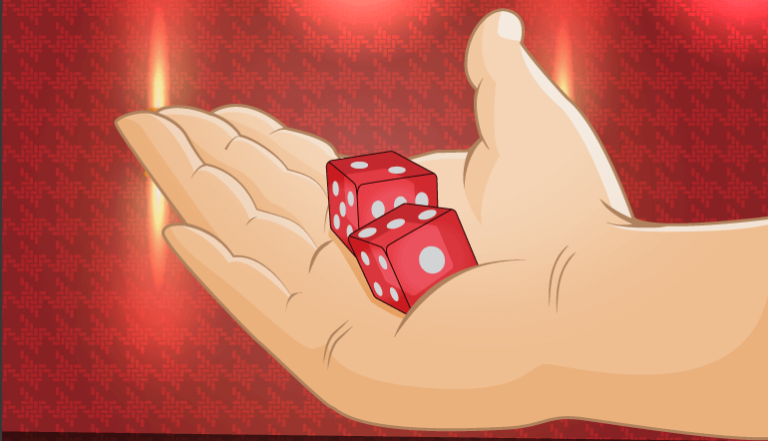Jumping in for some craps action can be some of the most fun a player can have in a casino. The action feels like a team approach with plenty of cheering and high fives if just the right numbers show up on those dice.
Craps is a great game where wins and losses can be quick and players will stay and play for hours if the table gets hot. A visit to the craps pit can be a high-energy experience and this popular dice game also has deep roots, keeping players entertained in numerous versions for centuries .
Keep reading to learn everything about the history of craps, perhaps the world’s most popular dice game.
Table of Contents
- How to Play Craps
- Craps in a Casino
- Street Craps
- Ancient Dice Games
- Transitioning More to the Modern Game
- Playing Craps in Today’s Casinos
1 – How to Play Craps
For many gamblers, craps can seem confusing at first. The table is typically large with numerous players crowded around and dropping chips seemingly everywhere on the felt. There are numerous possible betting locations and combinations, and it may seem like it’s impossible for dealers to keep up with everything.
That may be the case, but for most bettors there are only a few bets worth making. Craps can be one of the best bets in the house if a player makes the right wager. Here’s a general guide on how the game is played.
Craps in a Casino
Many players obviously first experience craps in a casino. While it may seem confusing, betting the Pass Line is the most popular wager and comes with the best odds. The action begins with the “come out roll.” The result of this roll can follow the following results:
- 2, 3, 12 – A player craps out and all players lose their Pass Line bets. Another come out roll then commences after players have reposted their wagers.
- 7 or 11 – These are automatic winners on the come out roll and players receives even money on their Pass Line wagers.
- 4, 5, 6, 8, 9, 10 – When of these numbers are rolled on the come out rolls it becomes the point number. The dealer will then place a puck on that number signifying that is the number the shooter is aiming for in subsequent rolls. The goal is to hit that number before “sevening out.” After the come out roll, a seven is the number players on the Pass Line don’t want to see. This number makes everyone a loser and the dealer scoops away all bets to the house.
Along with playing the Pass Line, which pays even money, players can also “take odds” on their wager by placing some chips behind that initial bet once a point number has been established. This is one of the best bets in the casino and plays the actual true odds of making that number. Those include:
- 6, 8 – 6 to 5
- 5, 9 – 3 to 2
- 4, 10 – 2 to 1
Those lucky enough to then see their point number then earn even money on the initial Pass Line bet as well as those odds on the wager behind the bet.
On the flip side players can also bet the “Don’t Pass,” betting against the shooter. There are numerous other wagers on the craps table, but these are the basics and the most popular options for players looking at the best-odds wagers.
Street Craps
This version of the game allows players to play in any setting and has been played by gamblers for generations. There is no ornate craps table and players generally are only focused on hitting their point number. One player generally acts as the house while another player functions as the shooter. Other players may also be involved betting for or against the shooter.
As at a casino, a player wins on 7 or 11 on the come out roll and loses on 2, 3, or 12. Once a point number is established the shooter continues rolling hoping to hit that point number.
Many of these informal craps games only use the point number as an opportunity for players to win their even-money Pass Line wager. More advanced and intricate wagers will usually be only found at a casino. Now with a bit of information on how to play craps, here’s a look at how this popular game evolved.
2 – Ancient dice games
The idea of rolling dice betting has been around since ancient times. That included the rolling of dice in some form of wagering dating all the way back to the Roman Empire. Many accounts say that Roman soldiers were some of the early practitioners of betting on dice. Instead of slick modern dice, soldiers shaved pig knuckles into cubes. They could then toss these cubes into their shields as they awaited the next battle.

Through the years, centuries to come, many more soldiers would pass the time when not in battle with some gambling on cards and dice. Those games among Roman soldiers are believed to have brought about the saying “roll the bones,” which is still often used today.
By the 13th Century, King Alphonso X of Castile, Spain, was so enamored with gambling that he commissioned the Book of Games, which featured 98 pages and 150 illustrations.
“About two-thirds of the game focus on chess, with dice and board games taking up the rest,” author David Schwartz notes in the book Roll the Bones: The History of Gambling. “The king contrasted games of skill, such as chess, with those of luck, like dice, and found that games like backgammon, which incorporated skill, were more popular, even though they could be played with dice.”
His interest in the subject may show just how popular gambling, and using dice in these efforts, were at the time among royalty and those in the upper class. Alphonso’s book even offered his views on the correct shape and form of dice to avoid cheating. Those that were misshapen could garner more “trickery than luck.”
The book focused on several games at the time, most using three dice. Two games Alphonso described, Hazard and Marlota, may be somewhat similar to the modern game of craps. Both featured players rolling dice, trying to reach a number before an opponent rolls that number.
Hazard is believed to have been invented by England’s Sir William of Tyre during the Crusades around 1125. Like many soldiers through the years, he and his knights gambled as a way to pass the time. The game is believed to have received the name after waiting to take a castle named Hazarth in Syria.
That seems fitting as some of these early versions of craps apparently spread from the Middle East. Dice gambling games seem to have become en vogue as traders came and went throughout the region, bringing those gambling games back home
“The word hazard was apparently derived from the Arabic word az-zahr,” Scwartz notes in Roll the Bones. “According to one account, Europeans learned of the game following an eighth-century Saracen invasion of Corsica, from whence it filtered to the Continent.”
Accounts vary to some degree, but it’s a good bet the game was spreading out during this time and was well-established among players throughout Europe and the Middle East by the 13th century. During this time, even Italian poet Patrarch commented on gambling and dice in his work Remedies for Fortune Fair and Foul. The man who was considered the father of the Renaissance apparently wasn’t a fan of rolling the bones.
Petrarch described gambling with dice as “an inexplicable, gaping cesspool leading to abject desperation.” Many players have probably felt those dice were against them at times, but maybe not to the extent as Petrarch. The poet further outlined his views on the game, describing dice as leading to “pain and anguish.”
3 – Transitioning More to the Modern Game of Craps
By the 1600s, Hazard had grown in popularity throughout Europe and would become extremely popular among gambling houses in England for the next 200 years. Crockford’s Casino was founded in London in 1823 and offered “gentleman” the opportunity to bet some pounds and shillings on a regular basis. The club was founded by William Crockford, who became one of the wealthiest men in the country at the time.
Like some modern Las Vegas casinos, the property attracted plenty of big names with even the Duke of Wellington believed to have been a member. The casino, which remained open until 1970 (although a newer club uses the same name), also was home to very popular Hazard games.
“The most fashionable club before the establishment of the Coventry (House Club) was Crockford’s, and I was elected to it immediately after being returned for Parliament (in 1842),” writer and politician Sir William Gregory noted in his autobiography. “It was admirably kept. Francatelli, the cook, was unequaled; there was a first-rate supper, gratis, with the best champagne for those who hungered and thirsted after midnight; and in a little room off the supper-room was the gambling table, at which too many an ardent admirer of Hazard had lost all his fortune.”
By the mid-1700s the game had become known as Crabs in France, the nickname for the worst possible hand in the game. At the same time, the game spread to regions controlled by the French in North America including Canada and Maine, now part of the U.S.
In 1755, the French region of Acadia, which included Nova Scotia, Canada, changed hands to the British and many French settlers headed south to Louisiana. In New Orleans, also the birthplace of modern poker, the game was altered a bit to make it easier for a house to back the action or simply to play on the street among friends and acquaintances. The game also began taking on the name Craps, becoming the more modern game that many players recognize today, either at a casino or online.
“African-Americans were among the first players, and likely the inventors,” of American Craps,” author David Schwartz notes. “Black roustabouts and other river workers up and down the Mississippi were for years the most eager players of ‘American dominoes,’ which was played as a social game.”
4 – Playing Craps in Today’s Casinos
By World War I, the modern craps table layout as players know today could be found in many casinos around the U.S.. Terms like “Pass Line” could be found on the felt as seen at today’s Craps table. The game became especially popular with soldiers in both world wars.
Much of the modernization of the game is attributed to John H. Winn, a dice manufacturer in Philadelphia, Pennsylvania, in the United States. He has been nicknamed the “Father of Craps,” and certainly had a fitting last name for the game. By 1907, he’d designed and released the table felt and design that is still seen in most casinos today.

When gambling became legal in Las Vegas in 1931, Craps became the most popular table game in these Old West-style gambling houses. That popularity grew dramatically during World War II. Dice are small and easy to carry. Soldiers, looking for ways to pass some time, could pack them and then break out a set in the barracks or even on the front lines in Europe or Southeast Asia for some street craps with a few dollars on the line.
After the war, many of these former soldiers turned to casinos in Las Vegas or the Caribbean to play the game they’d grown to love while in the service. The new house-backed casino version became very popular as a result (as did poker because of the same reasons). Interestingly, the game also began to flourish in Europe, where early dice games originally led to modern craps itself.
Craps can now be found in casinos around the world and is one of the games that quickly comes to mind when people think of casino gambling. Players can also find real-money craps online as well as free-to-play video game versions as well. Even with nothing on the line, some players just enjoy seem which ways those dice will roll.
Craps has been featured in Hollywood films through the decades and in other pop culture representations. The game’s unique jargon has been embraced in wider usage, with sayings like “crapping out” or “just a roll of the dice” used in everyday conversations.
Craps is one of the best games in a casino and can bring plenty of fun as you roll those bones and hope for a winning number. The game has a deep history and keeps many gamblers coming back for more.



















